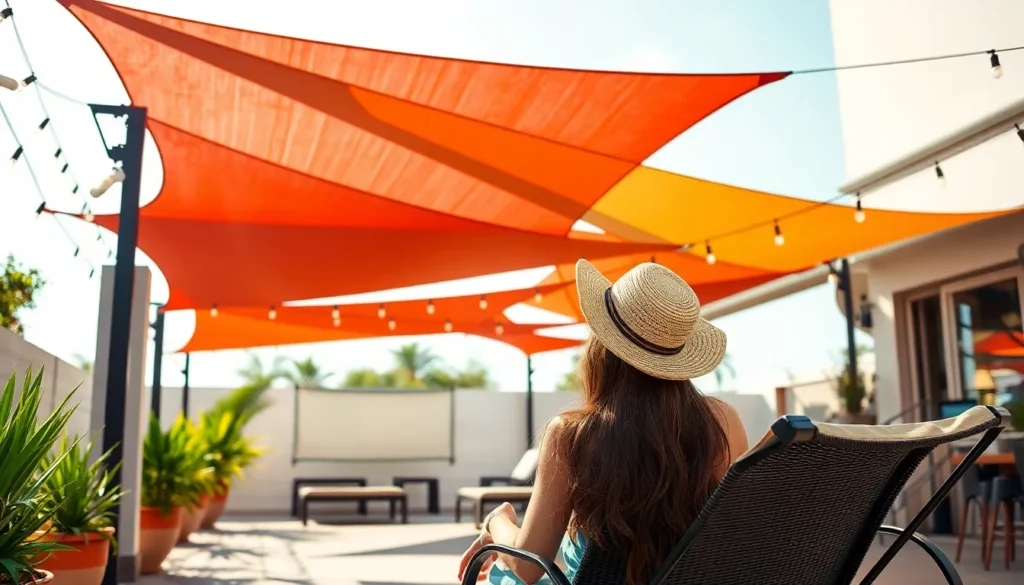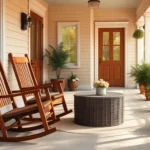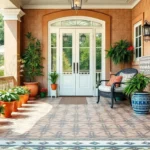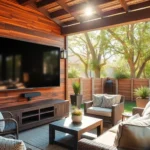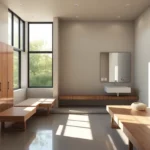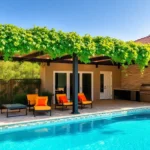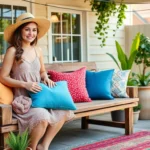We’ve all been there – stepping onto our beautiful patio only to be driven back indoors by scorching sun rays that make outdoor relaxation impossible. Shade cloth answers transform your patio from an unused space into a comfortable outdoor oasis where you can actually enjoy spending time.
Installing the right shade cloth doesn’t just provide relief from harmful UV rays; it creates an inviting atmosphere that extends your living space beyond four walls. Whether you’re looking for permanent shade structures or flexible options that adapt to changing weather conditions we’ll show you creative ways to maximize your patio’s potential.
From stylish sail shades that add architectural interest to retractable systems that give you complete control over sun exposure the possibilities are endless. We’re here to guide you through innovative shade cloth ideas that’ll make your patio the envy of the neighborhood while keeping you cool and comfortable all season long.
Choose the Right Shade Cloth Material for Your Patio
Selecting quality material determines how well your shade cloth performs and lasts through seasons of outdoor use. We’ll explore the most popular patio shade cloth options to help you make an well-informed choice.
HDPE vs. Vinyl vs. Canvas Options
HDPE (High-Density Polyethylene) delivers exceptional durability while maintaining breathability for your patio space. This synthetic material resists tearing and fading better than most alternatives, making it ideal for permanent installations. We recommend HDPE shade cloth for patios that need consistent protection throughout the year.
Vinyl shade cloth offers waterproof protection that completely blocks rain and sun from reaching your patio. This material creates a more enclosed feeling since it doesn’t allow air circulation like HDPE options. Vinyl works best for patios where you want complete weather protection rather than just sun filtering.
Canvas materials provide a classic aesthetic that complements traditional patio designs beautifully. These natural fiber options offer moderate sun protection while allowing gentle air movement through the weave. Canvas shade cloth requires more maintenance than synthetic alternatives but creates an elegant outdoor atmosphere.
UV Protection Ratings and Durability
UV Protection Factor (UPF) ratings indicate how effectively shade cloth blocks harmful ultraviolet rays from reaching your skin. We measure these ratings from UPF 15 to UPF 50+, with higher numbers providing superior protection.
| Material Type | Typical UPF Rating | Expected Lifespan | Maintenance Level |
|---|---|---|---|
| HDPE | UPF 30-50+ | 8-12 years | Low |
| Vinyl | UPF 50+ | 5-8 years | Medium |
| Canvas | UPF 15-30 | 3-5 years | High |
Durability factors include resistance to wind, rain, and temperature fluctuations that affect patio shade cloth performance. HDPE materials withstand weather extremes better than canvas options, which can shrink or stretch with moisture changes. Vinyl products resist moisture damage but may crack in freezing temperatures.
Color retention varies significantly between shade cloth materials, with darker colors generally fading faster than lighter alternatives. We’ve found that neutral tones like beige, gray, and white maintain their appearance longest when exposed to direct sunlight daily.
Install Overhead Canopy Shade Cloth Systems
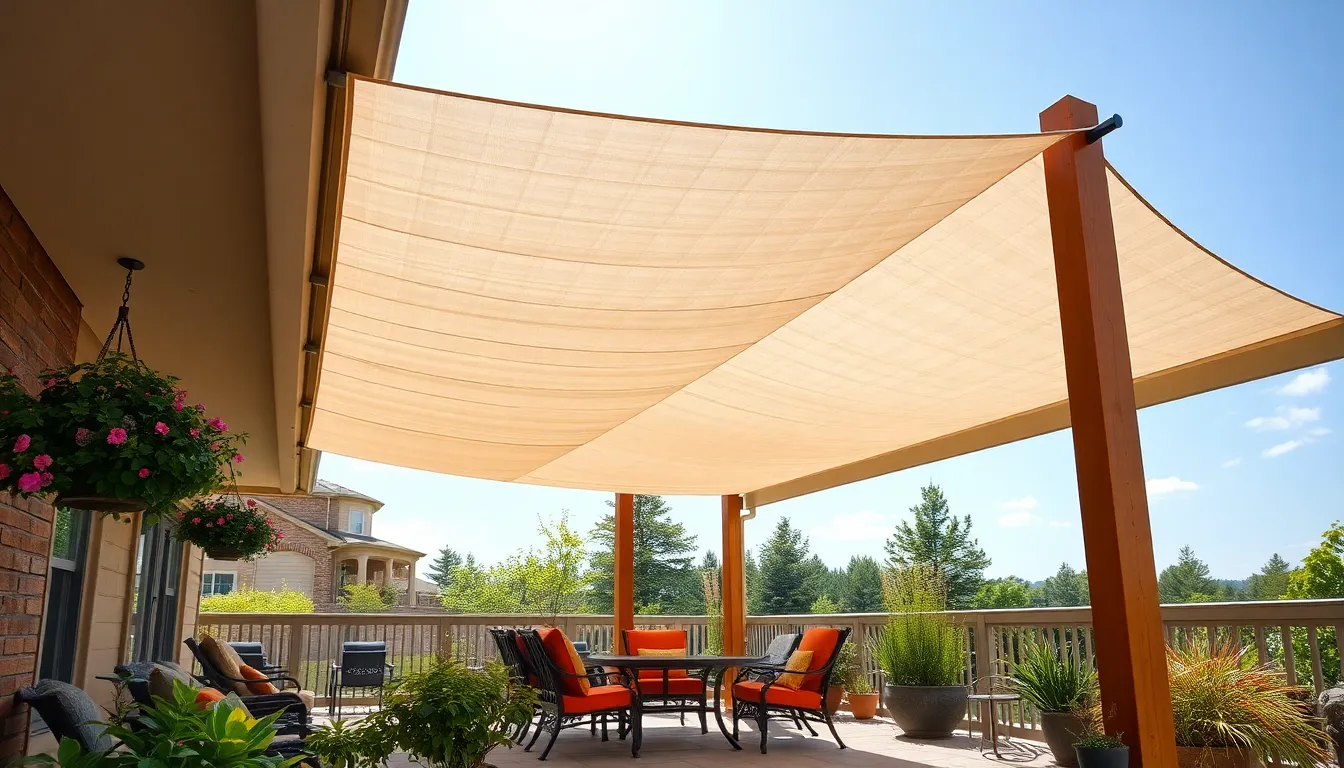
Overhead canopy shade cloth systems create breathable coverage that transforms your patio into a comfortable outdoor retreat. These versatile installations stretch fabric across your space while maintaining airflow and reducing sun exposure.
Permanent Post and Frame Installation
Permanent posts create the foundation for long-lasting patio shade. We recommend using 4×4 cedar posts anchored in concrete footings for maximum stability. Installing posts in half-barrel planters filled with crushed stone offers an alternative method that doesn’t require permanent ground excavation.
Measure your patio dimensions carefully before positioning posts. Place posts at strategic corners to support your shade cloth with proper tension. Using a level ensures vertical alignment during installation, preventing sagging or uneven coverage.
Frame construction connects your posts for optimal shade cloth support. Metal or wooden frames between posts create anchor points for tensioning systems. Installing the frame with a slight slope allows water runoff during rain, protecting both fabric and structure.
Tension your shade cloth across the completed frame system. Attach fabric corners to frame anchor points using stainless steel hardware designed for outdoor use. Adjusting tension prevents fabric flutter while maintaining the elegant appearance of your canopy.
Retractable Canopy Answers
Retractable systems provide adjustable shade coverage based on your daily needs. These canopies mount on cables or tracks that allow extending or retracting fabric as weather conditions change. Manual operation offers simple control, while motorized versions provide convenient push-button adjustment.
Cable mounting systems attach to existing patio structures or posts. Install cables between anchor points using tensioning hardware that maintains proper fabric alignment. Mounting retractable tracks to pergolas or patio covers creates seamless integration with existing outdoor features.
Fabric protection extends canopy lifespan through proper retraction. Rolling or folding the canopy when not in use shields material from UV damage and weather exposure. Storing fabric in retracted position during storms prevents wind damage and maintains structural integrity.
Operating mechanisms vary from simple pulleys to sophisticated motor systems. Hand-crank operation provides reliable manual control without electrical requirements. Motorized systems include remote controls and weather sensors that automatically retract canopies during high winds.
Create Partial Shade with Side Panel Installations

Side panel installations extend your patio’s shade coverage beyond what overhead systems alone can provide. We recommend adding vertical panels to block low-angle sun rays that slip under traditional canopies during morning and afternoon hours.
Privacy Screen Combinations
Privacy screens paired with shade cloth systems create secluded outdoor retreats that shield you from neighboring views. Combining shade sails with wooden lattices transforms your patio into a private sanctuary while maintaining airflow through the space. Bamboo panels offer natural texture and complement fabric shade structures beautifully.
Retractable privacy panels provide flexibility when you want to adjust your level of seclusion throughout the day. Fixed screens work well for permanent installations where consistent privacy remains essential. We suggest incorporating climbing vines on trellises alongside your shade cloth to enhance natural privacy while adding greenery to the area.
Fabric curtains hung from pergola frames double as both privacy barriers and additional shade providers. These panels can be drawn back during cooler weather or when you want to open up the space. Outdoor fabric options resist fading and moisture while maintaining their appearance season after season.
Wind Protection Benefits
Wind protection transforms blustery patios into comfortable outdoor dining and lounging spaces. Dense fabric screens or woven panels reduce wind flow without completely blocking beneficial airflow that keeps the area cool. Strategic placement of side panels creates windbreaks that make outdoor furniture more stable and enjoyable to use.
Well-designed shade cloth installations with side panels balance sun protection, privacy needs, and wind deflection in one functional system. Fabric panels filter harsh gusts while allowing gentle breezes to circulate through the space. We find that properly installed side panels significantly improve comfort levels during windy conditions.
Layered shade sails positioned at different angles enhance wind deflection while creating ever-changing shaded corners throughout your patio. This approach provides multiple benefits by addressing sun, privacy, and wind concerns simultaneously. The result is a more usable outdoor space regardless of weather conditions.
Design Geometric Patterns with Multiple Shade Cloths
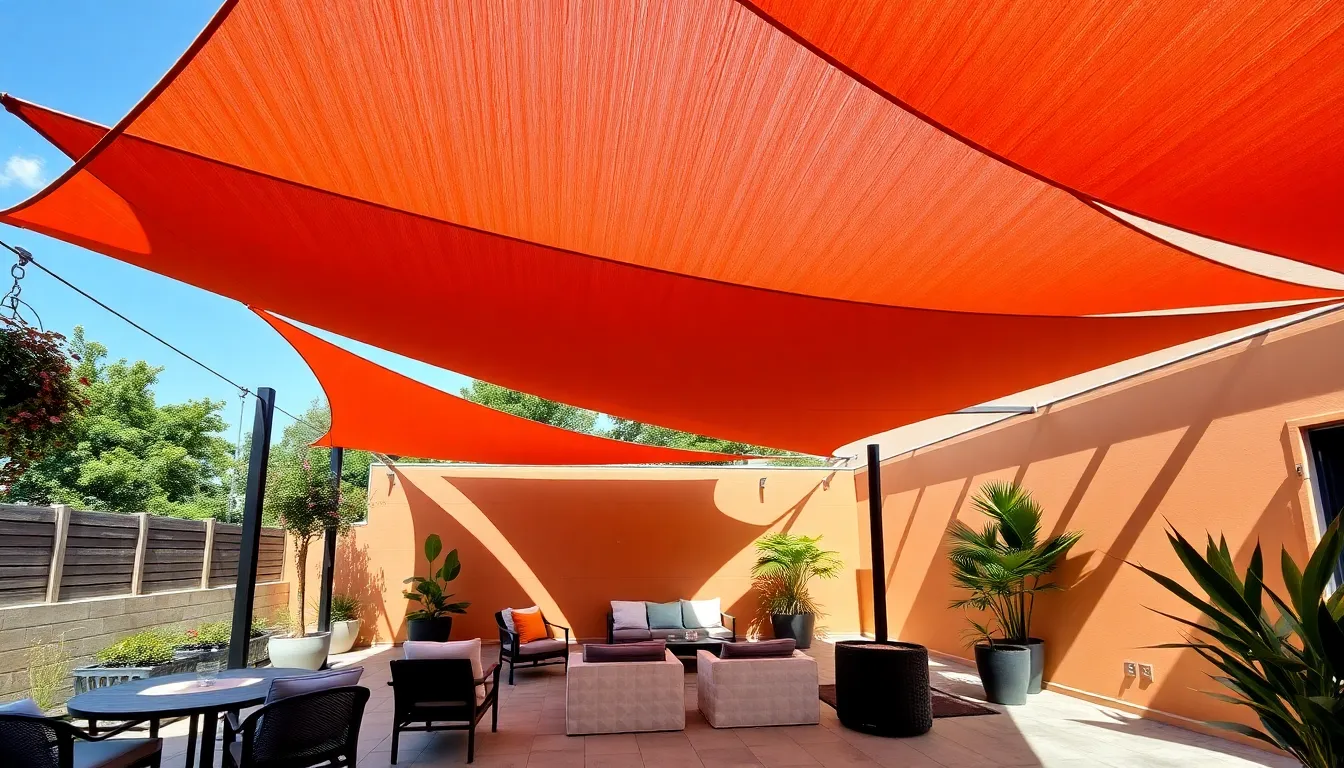
Creating visually stunning patio shade becomes effortless when we combine multiple shade cloths in geometric arrangements. These multi-sail configurations offer both enhanced coverage and striking architectural appeal that transforms any outdoor space.
Triangle and Diamond Configurations
Triangle shade sails deliver modern elegance while maximizing functional coverage across your patio space. We can overlap two triangular sails at their bases or tips to form diamond patterns that create ever-changing layered shading zones. These configurations follow the sun’s path throughout the day, ensuring consistent protection during peak hours.
Combining triangles with diamond shapes produces visually captivating patterns that enhance your patio’s aesthetic appeal. Sharp geometric lines add contemporary flair while practical sun protection keeps outdoor areas comfortable. We recommend mixing different sized triangles to create asymmetrical designs that break up monotonous coverage patterns.
Diamond configurations work exceptionally well for covering larger patio areas without requiring massive single installations. Multiple smaller geometric shapes provide better wind resistance than one large sail while offering greater design flexibility. These arrangements also allow us to adjust individual sections based on seasonal sun angles or exact activity zones.
Layered Height Variations
Installing shade sails at different heights creates sculptural depth that transforms patios into architectural showcases. We mount sails on poles or existing structures at staggered levels to improve sun blockage during various times throughout the day. This approach enables proper airflow and light filtration while providing striking visual elements.
Height variations enhance both functionality and aesthetic appeal by creating three-dimensional shade coverage. Staggered mounting positions allow air circulation beneath the fabric layers, keeping shaded areas cooler without trapping heat. We can adjust heights based on surrounding industry features or architectural elements for seamless integration.
Layered installations offer superior wind deflection compared to single-plane shade systems. Multiple sails positioned at different angles create effective windbreaks while maintaining breathable coverage. These configurations provide versatile shaded zones that adapt to changing weather conditions throughout the season.
Incorporate Shade Cloth into Pergola Structures
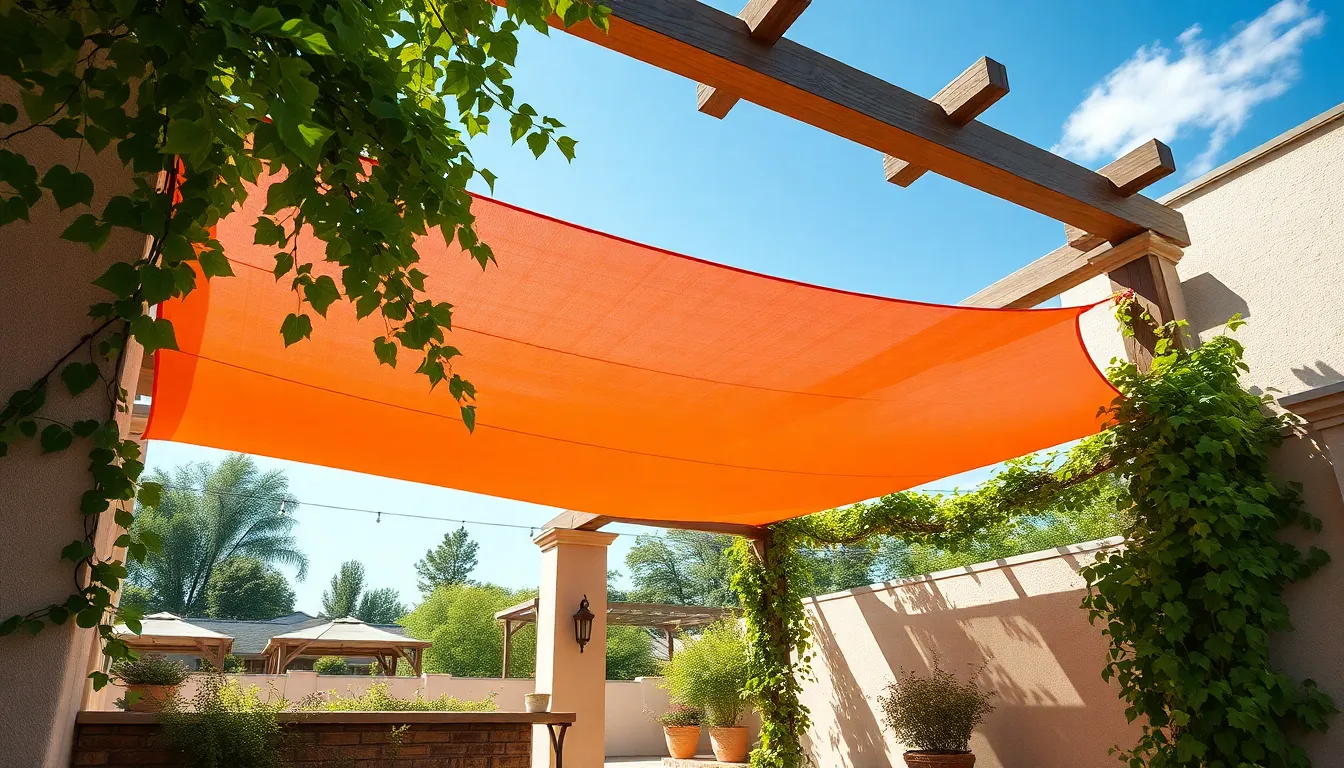
Pergolas provide an excellent framework for shade cloth installation, offering both versatility and effective sun protection. We can transform these structures into comfortable shaded retreats while maintaining the airflow that makes outdoor living enjoyable.
Attachment Methods for Existing Pergolas
Direct beam mounting offers the most secure attachment method for existing pergolas. We install eye hooks or screw hooks directly into the pergola’s perimeter beams, then attach shade cloth using bungee cords or rope for easy tensioning. This approach works particularly well with grommeted shade cloth that allows for multiple attachment points.
Track and rail systems provide the ultimate flexibility for seasonal shade adjustments. We mount these systems along the pergola’s roof structure or side beams, allowing the shade cloth to roll or slide as needed throughout the day. Installing tracks on opposing sides creates a smooth operation that lets us extend or retract coverage based on sun position and weather conditions.
Retractable mechanisms combine convenience with customization for varying shade requirements. We can install manual crank systems for budget conscious installations or upgrade to motorized systems for effortless operation. These systems protect the shade cloth from weather damage when retracted and extend its lifespan significantly.
Fastener combinations using grommets, clips, and tensioning hardware ensure secure installation across different pergola designs. We typically space attachment points every 3 to 4 feet along the pergola frame to prevent sagging and maintain proper tension. This spacing also distributes wind loads evenly across the structure.
Integration with Climbing Plants
Vine selection plays a crucial role in creating layered shade with natural cooling benefits. We recommend grape vines for their dense foliage and seasonal fruit production, or flowering vines like clematis for colorful blooms that complement the shade cloth. Fast growing options such as morning glory or passion vine establish coverage quickly in the first season.
Structural compatibility requires careful consideration when combining plants with shade cloth installations. We avoid destructive species like wisteria unless the pergola has reinforced construction, as these aggressive climbers can damage both the structure and shade cloth over time. Instead, we choose plants that climb using tendrils or twining stems rather than adhesive roots.
Seasonal layering creates ever-changing shade coverage that changes throughout the year. We position shade cloth as the primary coverage while training climbing plants to grow over and alongside the fabric. This combination provides immediate shade from the cloth while the plants establish, then offers enhanced natural cooling as the vegetation matures.
Maintenance planning ensures both shade cloth and climbing plants remain healthy and attractive. We install the shade cloth with enough clearance for plant growth and pruning access. Regular vine trimming prevents overgrowth that could tear or stain the fabric, while proper plant selection reduces maintenance requirements throughout the growing season.
Build Freestanding Shade Cloth Structures

Building freestanding shade cloth structures gives you complete control over placement and design without depending on existing buildings. These versatile installations work perfectly when you need shade coverage away from your home’s walls or roofline.
Portable Frame Systems
Portable frame systems offer maximum flexibility for renters and homeowners who prefer temporary shade answers. These lightweight structures typically feature metal or PVC pipe frames that assemble and disassemble quickly without tools.
Frame Material Options:
- Aluminum tubing provides rust resistance and durability
- PVC pipes offer affordability and easy customization
- Steel frames deliver maximum strength for windy conditions
Modern portable designs incorporate retractable awnings that adjust throughout the day as the sun moves. Cantilever umbrellas with wheeled bases allow you to reposition shade coverage within minutes. Some systems include snap-on connectors that secure shade cloth panels without permanent fasteners.
Mobility Features:
- Wheeled base systems for easy repositioning
- Collapsible frames that fit in storage sheds
- Quick-connect joints for tool-free assembly
- Carrying cases for transport to different locations
We recommend choosing frames with adjustable height settings to accommodate various shade cloth sizes. These systems work exceptionally well for seasonal use or when you’re testing different shade configurations before committing to permanent installations.
Ground Anchor Answers
Ground anchor answers provide the foundation stability that keeps your freestanding shade structures secure during storms and high winds. Proper anchoring prevents dangerous structural failure and protects your investment in quality shade cloth.
Permanent Anchor Types:
- Concrete footings with embedded posts for maximum stability
- Ground sleeves that accept removable posts
- Helical anchors that screw deep into soil
- Weighted concrete bases for semi-permanent installations
Permanent anchors require concrete footings where posts embed at least 2 feet deep for standard 8-foot structures. We suggest using quick-setting concrete mix that cures within 30 minutes for faster installation. Post spacing should match your shade cloth dimensions with additional support posts every 10-12 feet to prevent sagging.
Temporary Anchor Options:
- Heavy-duty ground stakes for soft soil conditions
- Auger anchors that twist into hard-packed ground
- Sandbag weights for paved surfaces
- Water-filled bases that provide 100+ pounds of stability
Choose anchor types based on your soil conditions and expected weather patterns. Sandy soil requires deeper embedment or additional weight, while clay soil holds standard anchors effectively. We always recommend checking local building codes before installing permanent concrete footings, as some municipalities require permits for structures over certain sizes.
Combine Shade Cloth with String Lights for Ambiance
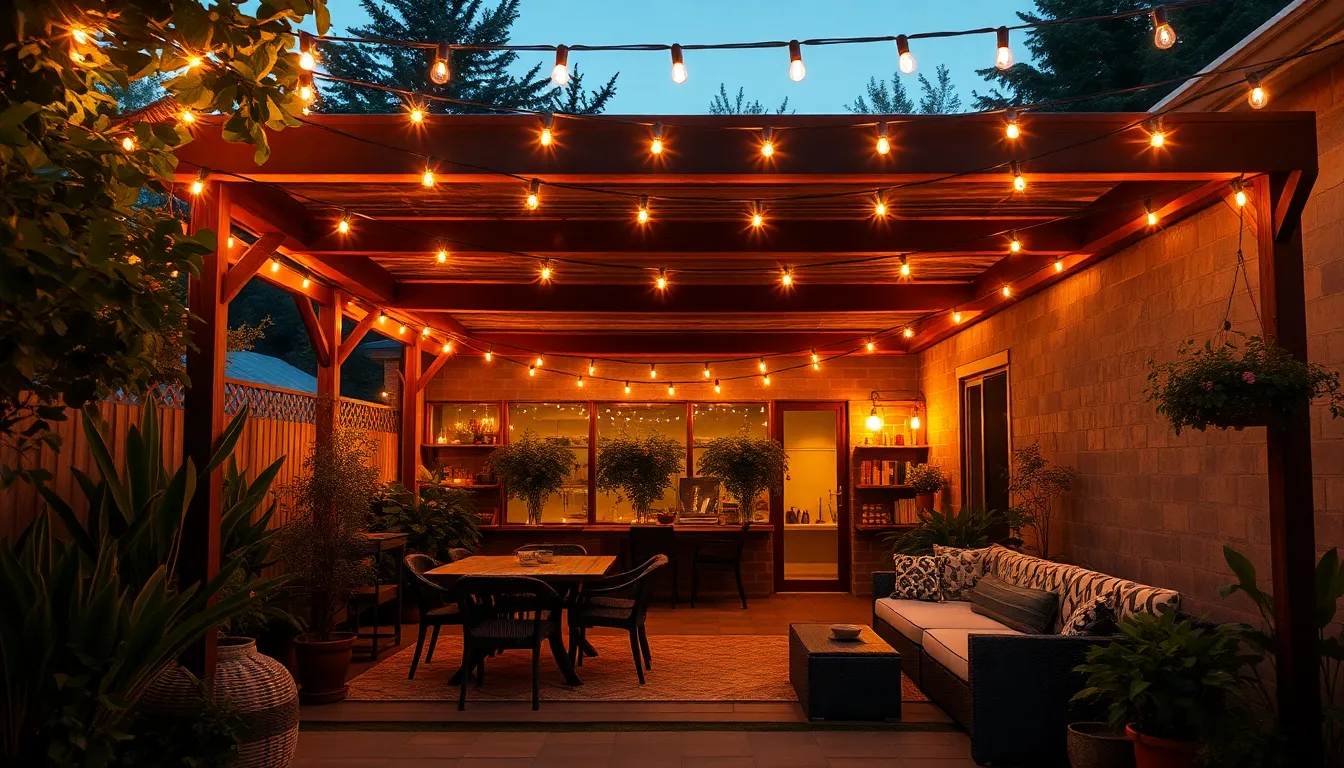
String lights transform your shaded patio into a magical evening retreat that extends outdoor enjoyment well after sunset. We’ll show you how to seamlessly integrate lighting with your shade cloth system for both function and atmosphere.
Lighting Placement Strategies
Edge illumination creates the most dramatic effect by running string lights along the perimeter of your shade cloth or sail edges. This technique highlights the fabric’s shape while providing even ambient coverage across your patio space.
Crisscross patterns maximize light distribution and visual interest by weaving multiple strands across support beams or pergola frames. We recommend spacing parallel runs 3 to 4 feet apart to eliminate dark spots and create uniform brightness.
Zone exact lighting ensures adequate illumination where you need it most by positioning concentrated strands above dining tables, seating areas, and outdoor kitchens. Task lighting becomes essential for food preparation and reading while maintaining the overall ambiance.
Layered lighting approaches combine string lights with lanterns, solar garden lights, and LED spotlights to create depth and versatility. Multiple light sources allow you to adjust brightness levels throughout the evening and accommodate different activities.
Height variation adds visual dimension by hanging some strands closer to the shade cloth while others drape lower toward seating areas. This technique creates intimate pockets of light while maintaining broader coverage across the entire space.
Weatherproof Electrical Considerations
Outdoor rated fixtures are absolutely essential for any patio lighting installation, as indoor lights will fail quickly when exposed to moisture, heat, and UV radiation. Look for IP65 or higher ratings to ensure your string lights can withstand rain, snow, and temperature extremes.
GFCI protection prevents electrical hazards by immediately shutting off power when moisture is detected in the circuit. We always install GFCI outlets for any outdoor electrical connections, as they’re required by electrical codes and provide critical safety protection.
Waterproof enclosures protect all electrical connections, junction boxes, and outlets from water infiltration that could cause shorts or fires. Use weatherproof covers on outlets and ensure all wire connections are made inside sealed enclosures.
Secure cable management prevents damage from wind movement and reduces wear on electrical connections by properly fastening all wiring to support structures. We use cable clips, conduit, and tension relievers to eliminate stress points that could cause failures.
Solar and battery alternatives eliminate wiring concerns entirely while providing reliable illumination for your shade cloth areas. These systems offer easy installation, reduced electrical hazards, and lower operating costs compared to hardwired answers.
Circuit load calculations ensure your electrical system can safely handle the additional lighting without overloading existing circuits. Most residential circuits can support 15 to 20 strings of LED lights, but always verify capacity before installation.
Use Color and Texture to Enhance Patio Aesthetics
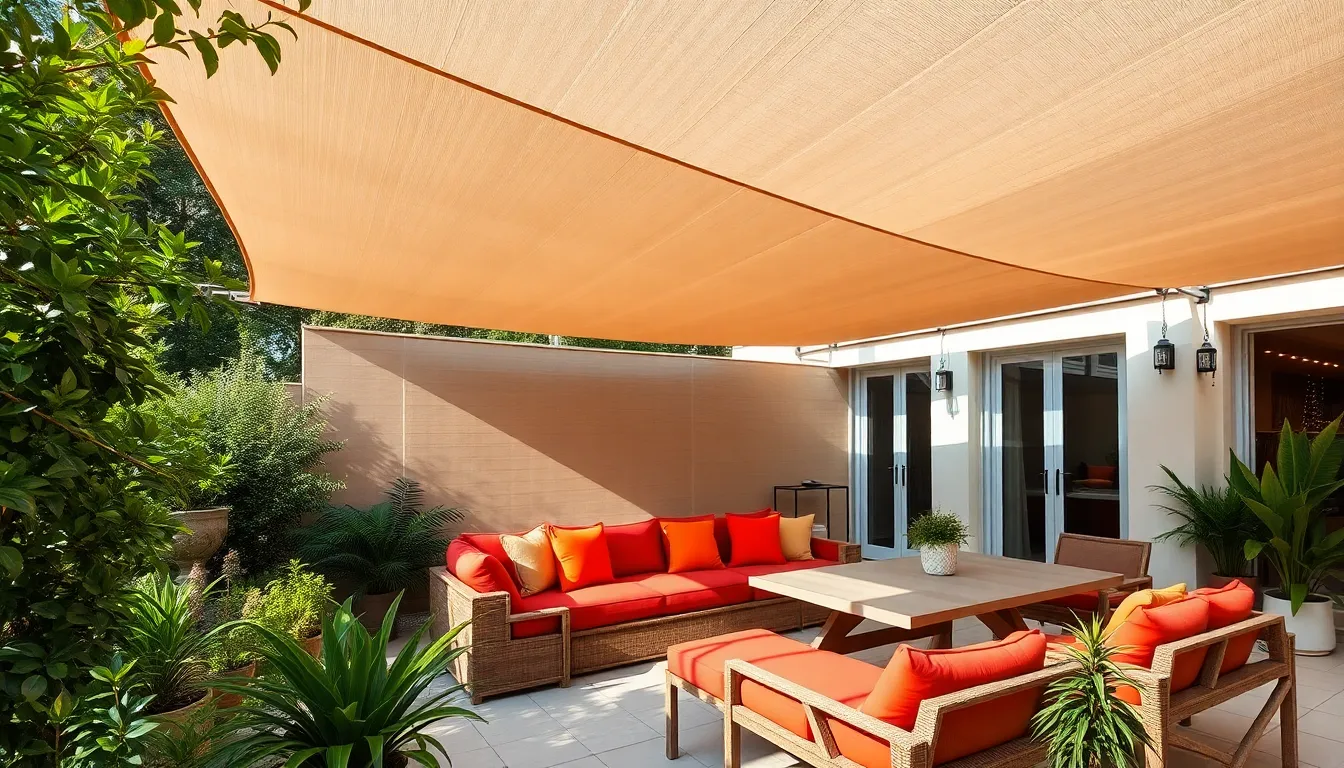
Now that we’ve covered the structural aspects of shade cloth installation, let’s explore how thoughtful color and texture choices can transform your patio’s visual appeal. Strategic selection of these elements significantly impacts both functionality and aesthetic harmony.
Neutral Tones for Versatile Design
Neutral tones provide the foundation for versatile patio design that adapts to changing décor styles. Whites, beiges, and soft grays complement virtually any outdoor furniture arrangement while creating a calm backdrop for other design elements. We find these colors particularly effective because they allow plants, colorful cushions, and decorative rugs to become the focal points of your space.
Classic combinations like black and white striped retractable awnings deliver timeless elegance. These patterns pair beautifully with both modern and traditional furnishings, ensuring your investment remains stylish for years. Light colored materials in neutral shades brighten darker patios by maximizing the diffusion of natural sunlight.
Texture selection becomes crucial when working with neutral palettes. Fabric based shade sails and canopies introduce soft textures that create visual contrast against harder patio surfaces like concrete or stone. This interplay between materials adds depth without overwhelming the overall design scheme.
Vinyl materials in neutral tones offer practical benefits alongside aesthetic appeal. They brighten enclosed spaces while providing weather resistance, making them ideal for pergola applications where longevity matters most.
Bold Colors for Statement Pieces
Bold colors transform shade cloth from functional necessity into striking focal points. Bright red, navy blue, and emerald green shade sails energize outdoor spaces while expressing personal style preferences. We recommend these vibrant choices when surrounding furniture and landscaping maintain more subdued color schemes.
Statement pieces work best when they contrast with existing patio elements. A brilliant red umbrella becomes the centerpiece against neutral furniture, while deep blue shade sails complement natural wood tones beautifully. These choices help define exact zones within larger patio areas.
Textural elements amplify the impact of bold color selections. Tasseled umbrellas and patterned fabric canopies combine visual interest with functional shade coverage. These details make patios feel intentionally designed rather than simply functional.
Creative combinations of bold colors with interesting textures elevate entire outdoor spaces. Mixing vibrant hues with varied fabric weights and patterns creates ever-changing visual experiences that change throughout the day as light conditions shift.
Maintain and Store Your Patio Shade Cloth
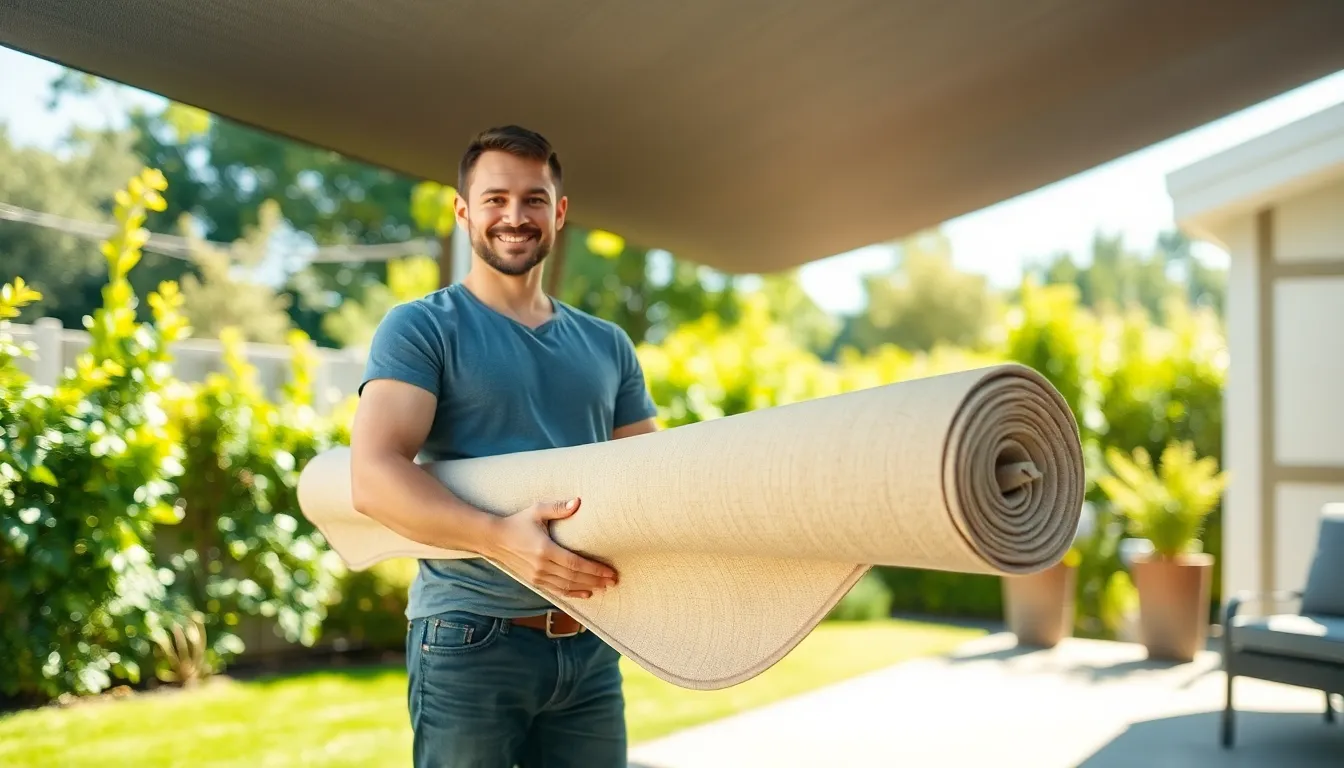
Protecting your investment in shade cloth requires proper maintenance routines and seasonal storage practices. We’ll guide you through the essential care techniques that keep your shade answers looking great and performing effectively year after year.
Seasonal Care and Cleaning
Canvas shade cloth needs gentle treatment with mild cleaning answers specifically designed for canvas materials. We recommend using a soft bristled brush to remove stains without damaging the fabric fibers. Thoroughly rinse the surface after cleaning and allow complete air drying before reinstallation. Applying fabric protectant spray enhances water resistance and provides additional protection against environmental elements.
HDPE shade cloth requires regular hosing to remove accumulated dust and loose debris from the surface. Deep cleaning involves using mild soap answers combined with soft brush scrubbing techniques. Avoiding abrasive cleaners protects the UV resistant coating that maintains the fabric’s protective qualities. Complete air drying prevents moisture related issues during storage or continued use.
Shade sails benefit from regular cleaning with soft brushes and mild detergent answers to prevent dirt accumulation. Thorough rinsing removes cleaning residue that might attract additional dirt over time. Complete drying prevents mold and mildew growth that can damage the fabric structure. High pressure washers should never be used as they can compromise the fabric integrity.
Regular inspection during cleaning helps identify small issues before they become major problems. We find that seasonal maintenance prevents premature wear and ensures continued UV protection effectiveness.
Proper Storage Techniques
Preparation steps include thorough cleaning and complete drying before any storage attempt. Storing damp fabric creates ideal conditions for mildew and mold growth that can permanently damage your shade cloth. We always verify complete dryness by checking all fabric areas including seams and hardware attachment points.
Folding and rolling methods significantly impact fabric longevity during storage periods. Rolling the fabric prevents sharp creases that can weaken fibers over extended storage times. Careful folding without creating permanent creases offers an alternative when rolling isn’t practical. Sharp fold lines become stress points that reduce the fabric’s structural integrity.
Storage location selection requires clean, dry, and pest free environments for optimal fabric preservation. We avoid areas with moisture exposure or locations where heavy items might compress the stored fabric. Organizing and labeling installation hardware simplifies the reinstallation process when the season returns. Proper component storage prevents lost hardware that delays setup.
Pest protection measures include regular inspection of storage areas for rodents and insects that might damage fabric. We recommend checking storage spaces before placing shade cloth to ensure pest free conditions. Protective storage containers or sealed bags provide additional security against unwanted visitors during extended storage periods.
Following these maintenance and storage techniques extends your patio shade cloth’s functional life while preserving its appearance and protective qualities throughout multiple seasons.
Conclusion
We’ve explored many shade cloth answers that can transform your patio into a comfortable outdoor retreat. From permanent overhead canopies to flexible retractable systems each option offers unique benefits for different needs and budgets.
The key to success lies in choosing the right materials and installation methods for your exact situation. Whether you’re dealing with intense afternoon sun or creating a wind-protected dining area these shade cloth ideas provide practical answers that enhance both comfort and aesthetics.
With proper installation and maintenance your patio shade cloth investment will provide years of reliable protection and enjoyment. We encourage you to experiment with different configurations and colors to create the perfect outdoor space that reflects your personal style.
Frequently Asked Questions
What is shade cloth and how can it transform my patio?
Shade cloth is a protective fabric designed to block UV rays and reduce heat on patios. It transforms uncomfortable sunny spaces into inviting outdoor oases by providing cooling shade, UV protection, and extending your usable living space. Available in various materials and configurations, shade cloth creates a comfortable atmosphere for relaxation and entertainment throughout the day.
What are the best materials for patio shade cloth?
The three most popular materials are HDPE (High-Density Polyethylene) offering durability and breathability, vinyl providing waterproof protection with limited airflow, and canvas delivering classic aesthetics but requiring more maintenance. HDPE is ideal for most applications due to its UV resistance and air circulation properties, while vinyl works best in wet climates.
How do I install overhead canopy shade cloth systems?
Start by installing 4×4 cedar posts anchored in concrete for stability. Measure carefully and place posts strategically to ensure proper tension and alignment. Create a frame system between posts, then attach the shade cloth with appropriate hardware. Proper installation requires attention to measurements, post placement, and tensioning to achieve optimal coverage and durability.
What are retractable canopy systems and their benefits?
Retractable canopy systems feature adjustable shade coverage using cable or track-mounted mechanisms. They allow you to extend or retract fabric based on daily sun conditions and weather needs. Benefits include protecting the canopy from UV damage when not in use, operating convenience through manual cranks or motorized systems, and flexibility in shade management.
How can side panels enhance my patio shade coverage?
Side panels block low-angle sun rays and provide additional privacy while enhancing overall shade coverage. They can be combined with existing shade cloth systems to create secluded outdoor retreats. Options include wooden lattices, bamboo panels, retractable privacy screens, and fabric curtains, offering both functional shade and aesthetic appeal for comprehensive patio protection.
Can shade cloth provide wind protection for my patio?
Yes, dense fabric screens and woven panels can reduce wind flow while maintaining proper airflow. Strategic placement of side panels creates effective windbreaks, enhancing comfort during blustery conditions. Layered shade sails positioned at different angles improve wind deflection and provide versatile coverage, making patios more comfortable in various weather conditions.
How can I create geometric patterns with multiple shade cloths?
Use triangle and diamond configurations to enhance both coverage and aesthetic appeal. Overlapping triangular sails create dynamic shading zones that adapt to the sun’s path throughout the day. Layered height variations add visual depth and interest while improving sun blockage, airflow, and wind deflection for both functional and striking patio designs.
How do I integrate shade cloth with existing pergola structures?
Attach shade cloth to pergolas using direct beam mounting or track systems for seasonal adjustments. Install retractable mechanisms (manual or motorized) to protect fabric from weather damage. Consider integrating climbing plants with shade cloth for layered natural cooling. This combination provides enhanced shade coverage while maintaining the pergola’s structural integrity and aesthetic appeal.
What are freestanding shade cloth structures and their advantages?
Freestanding structures offer complete control over placement and design without requiring existing supports. Portable frame systems provide flexibility for renters and frequent movers. Frame materials include aluminum, PVC, and steel, with mobility features like wheeled bases and collapsible designs. Proper ground anchoring ensures stability and safety during storms and windy conditions.
How can I enhance my shaded patio’s ambiance with lighting?
Integrate string lights using edge illumination, crisscross patterns, and zoning strategies for specific areas. Use weatherproof electrical fixtures with GFCI protection for safety. Consider solar and battery alternatives for flexibility. Proper circuit load calculations prevent overloading existing systems. Strategic lighting placement creates a magical evening retreat atmosphere under your shade cloth coverage.
What colors and textures work best for patio shade cloth design?
Neutral tones offer versatile design compatibility with various décor styles, while bold colors create striking focal points. Combine different textures, such as fabric-based sails against hard surfaces, to add visual depth. Creative color and texture combinations elevate outdoor spaces, ensuring patios are both functional and visually captivating while complementing existing architectural elements.
How do I maintain and store my patio shade cloth properly?
Follow seasonal care routines specific to your material (canvas, HDPE, or shade sail fabric). Use gentle cleaning methods and ensure thorough drying to prevent mold and mildew. Store fabric by rolling or folding in pest-free environments. Regular maintenance including inspection for damage, proper cleaning, and correct storage extends the functional life and appearance of your investment.

